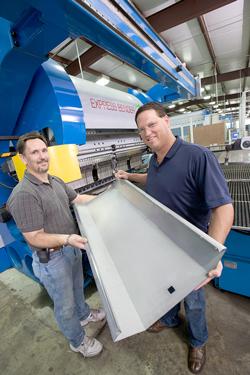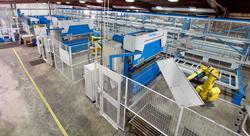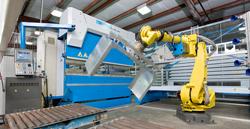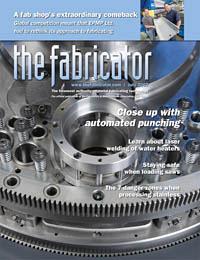- FMA
- The Fabricator
- FABTECH
- Canadian Metalworking
Categories
- Additive Manufacturing
- Aluminum Welding
- Arc Welding
- Assembly and Joining
- Automation and Robotics
- Bending and Forming
- Consumables
- Cutting and Weld Prep
- Electric Vehicles
- En Español
- Finishing
- Hydroforming
- Laser Cutting
- Laser Welding
- Machining
- Manufacturing Software
- Materials Handling
- Metals/Materials
- Oxyfuel Cutting
- Plasma Cutting
- Power Tools
- Punching and Other Holemaking
- Roll Forming
- Safety
- Sawing
- Shearing
- Shop Management
- Testing and Measuring
- Tube and Pipe Fabrication
- Tube and Pipe Production
- Waterjet Cutting
Industry Directory
Webcasts
Podcasts
FAB 40
Advertise
Subscribe
Account Login
Search
Knocked down, but not out
Contract manufacturer makes a comeback, modernizes, automates
- July 10, 2007
- Article
- Bending and Forming

Changing from manual processes to an automated flexible manufacturing system allows EPMP Ltd. to manufacture complex bent parts such as this one quickly and without the risk of handling damage.
It would be an understatement to say that contract manufacturer EPMP Ltd., Seguin, Texas, got off to an inauspicious start. After just four years of operation, Ernest Plant sold the slumping company in 1988. This appeared to be just another short story of a failed start-up manufacturing shop. However, in 1992 Clinton Plant and his father Ernest reacquired the company. This time failure was not an option — but the journey was not easy.
"We had a lot of obstacles to overcome," reflected Clinton Plant. "We had a small, 5,000-square-foot facility with just six employees; old sheet metal fabricating equipment; and a less-than-shining reputation. We spent the first six months rebuilding equipment so it could produce quality parts." Through hard work, wise business decisions, and some true Texas grit, the company started to grow. The company was profitable in the first year and in 1996 Clinton bought out his father.
With the growing success came new equipment—turret punch presses, press brakes, shears, welding machines, and so on—and a new 33,000-sq.-ft. manufacturing shop in McGregor, Texas, to augment the expanded, 56,000-sq.-ft. Seguin facility. Plant also cited the addition of key personnel, such as Craig Hickey, vice president of operations, as a reason for his company's success. Other key positions have been filled by managers with backgrounds from world-class OEMs and contractors who are tasked with implementing lean principles and continuous improvement methodologies to eliminate waste and maximize customer satisfaction.
Today EPMP's 85 employees provide fabricated sheet metal products to customers in such industries as lighting and electrical; heating, ventilation, and air conditioning (HVAC); and commercial construction.
Taking on Globalization
A few years ago EPMP realized that it was facing another challenge—competition from sheet metal fabricators offshore and across the border.
"The reality is that we are in a global economy," observed Plant. "In order to compete on a global basis, you don't have to work harder. You have to work smarter. This means you must automate. We are competing with labor costs, not material costs."
EPMP began its search for sheet metal fabricating automation equipment in early 2005.
"We were looking to fully automate," explained Plant. "We had been looking for parts-sorting automation for several years. With our traditional turret punch press, you had to pull the parts out of the skeleton. At one point just the labor for the sorting operation was costing us over $200,000 per year due to double and triple handling of the parts from punching to bending."
"We needed to remove the non-value-added steps of production from our process," added Hickey. "We had to find a way to reduce that cost and automate bending processes. We specialize in big parts, and it often takes two people to bend the large parts."
While automated bending was EPMP's biggest need, it also secured additional work in punching.

The machines in EPMP's flexible manufacturing system that are robotically loaded include press brakes, folding machines, and a combination machine that performs punching and shearing. Although the move to automation eliminated some positions, EPMP didn't eliminate the people—they were moved to more productive jobs in the company.
Ultimately, the company decided to purchase a flexible manufacturing system from Finn-Power. The system consists of an EBe servo-electric Express Bender with loading/unloading systems; two hydraulic press brakes with robots; two Shear Genius integrated punch/right-angle shear combination machines with loading, sorting, and a double-wagon stacking system; and the Night Train material management system for holding blank sheets and transferring punched sheets to the benders or press brakes.
The Night Train allows EPMP to bend only the parts needed for the day's production and allows the parts to be bent in sequences different from the punching sequences. This allows the company to match the output to their assembly needs. This reduces the labor content and makes better use of floor space by reducing work-in-process (WIP) or parts that are not needed immediately.
The bender automates every step of the bending cycle, from loading flat parts to unloading bent components. It has a maximum bending length of 84.65 inches (2,150 mm) and a maximum opening height of 8 in. (200 mm). Bending blade movements (vertical and horizontal) are driven by NC servo axes instead of hydraulic cylinders. The upper tool movements also are made by an NC servo axis.
Versatile Equipment, Flexible Planning
"Planning production is very important," said Plant. "We didn't want to run simple, single-setup parts on the Shear Genius and EBe that could be produced just as fast on the older turrets and press brakes. Our game plan was to take the large parts and the parts with multiple setups and put them on the EBe and robotic press brakes. We have light box parts that would take us eight hours to make 100 pieces. The bender produces 100 parts in one hour and 20 minutes. There are many parts that used to take five minutes to run and, depending on the part, now take less than 30 seconds on the EBe and robotic press brakes. It would take four press brakes and six people on two shifts to replace what the EBe can do in one shift."
"The fastest part we have on the EBe takes 29 seconds, and the longest part is about 52 seconds," added Barry Setzer, Night Train supervisor and programmer. "There are parts that used to take three days on three press brakes with three operators to make 100 pieces. Now we do the same part quantity in two to three hours with one EBe and one operator."
Currently EPMP processes more than 100 different part numbers on the bender, with more parts added each week. The single-piece-flow capability allows maximum efficiency in support of kanban management and eliminates traditional batching of jobs.
Getting a Handle on Part Handling
The Shear Genius eliminates wasteful skeletons and secondary operations such as deburring. Nibble edges on the part exteriors are eliminated with the integrated right-angle shear. The shear starts with a full-sized sheet of material and ends with a punched part after automated loading, punching, forming, shearing, stacking, and unloading, thereby achieving single-piece flow.
When EPMP initially went the automation route, its goal was to reduce labor costs on bending and sorting. It also realized another benefit: higher steel utilization, up to 98 percent on some parts. The use of automation also eliminated handling damage.
"Many of the parts we produce are finish-critical, such as prepainted and stainless," said Setzer. "We had a lot of material issues such as scratches, dents, pallets being dropped between operations. This has all been eliminated because now the parts automatically are sent from the Shear Genius straight to the stacker into the Night Train and to the bender. Instead of handling the part three or four times, we now touch the part just once."
According to Plant, the new equipment investments have allowed EPMP to increase production without having to add a third shift.

Industrial robots are helpful in eliminating the hazards associated with handling large, cumbersome parts.
"In our business, the schedule can change every time the phone rings," Plant said. "We need tremendous flexibility. This equipment has saved us on numerous occasions when material shipments were late or other production delays came into play. With the automation, we don't have to chase the truck out the door anymore with the last of the order. The parts are there waiting for the truck."
The More Things Change...
EPMP management is also very clear on why they chose to automate. "Automation did not replace employees," said Hickey. "We reassigned employees to more productive areas. We can double our capacity without doubling our head count. In fact, we could probably do it with six people and the Finn-Power cell."
"In order to stay ahead of the competition, you have to automate," concluded Plant. "You have to take some additional risks that perhaps the rest of the industry may not be willing to take. When we decided to automate, we raised the bar for the rest of the industry in our area. We changed the landscape. It's a tremendous risk to make that kind of investment under that kind of scenario of a global economy when everybody is packing up and moving to Mexico or China. You have to go with your gut. My gut said that if we automate that we would be able to compete. And we have proven that. We can now compete on fabricated parts from across the border."
subscribe now

The Fabricator is North America's leading magazine for the metal forming and fabricating industry. The magazine delivers the news, technical articles, and case histories that enable fabricators to do their jobs more efficiently. The Fabricator has served the industry since 1970.
start your free subscription- Stay connected from anywhere

Easily access valuable industry resources now with full access to the digital edition of The Fabricator.

Easily access valuable industry resources now with full access to the digital edition of The Welder.

Easily access valuable industry resources now with full access to the digital edition of The Tube and Pipe Journal.
- Podcasting
- Podcast:
- The Fabricator Podcast
- Published:
- 04/16/2024
- Running Time:
- 63:29
In this episode of The Fabricator Podcast, Caleb Chamberlain, co-founder and CEO of OSH Cut, discusses his company’s...
- Trending Articles
How to set a press brake backgauge manually

Capturing, recording equipment inspection data for FMEA

Tips for creating sheet metal tubes with perforations

Are two heads better than one in fiber laser cutting?

Hypertherm Associates implements Rapyuta Robotics AMRs in warehouse

- Industry Events
16th Annual Safety Conference
- April 30 - May 1, 2024
- Elgin,
Pipe and Tube Conference
- May 21 - 22, 2024
- Omaha, NE
World-Class Roll Forming Workshop
- June 5 - 6, 2024
- Louisville, KY
Advanced Laser Application Workshop
- June 25 - 27, 2024
- Novi, MI



























